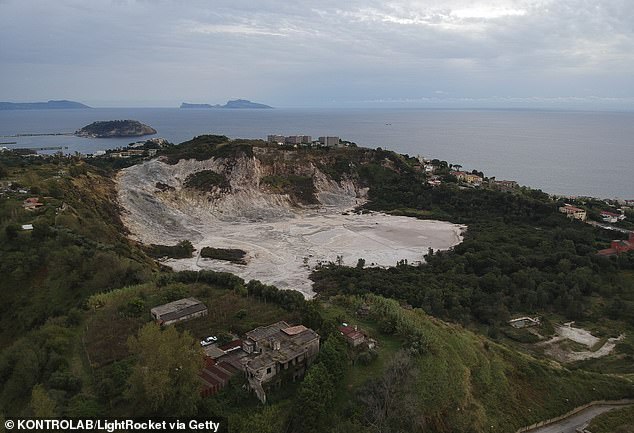A powerful series of earthquakes at Campi Flegrei, a massive supervolcano in Italy has raised fresh concerns among scientists about the risk of a major eruption.
In May, the Phlegraean Fields near Naples was shaken by a magnitude 4.4 earthquake, the strongest in 40 years.
Over the past six months, scientists have recorded more than 3,000 smaller quakes, known as tremors, a figure far above normal seismic activity for the area.
Experts say eruptions are usually preceded with the increase in earthquake activity, as underground pressure builds up.
These small quakes can weaken the rock above the volcano’s magma chamber, making it easier for magma to push through. Think of it like steam building in a pressure cooker, if the lid gets too weak, it could blow.
Geologists have also observed a sharp rise in gases being released from the volcano, another warning sign.
Adding to the alarm, carbon dioxide emissions from Campi Flegrei have surged, with Italy’s National Institute of Geophysics and Volcanology (INGV) reporting daily levels between 4,000 and 5,000 tons.
Experts say increased gas emissions often mean magma is moving closer to the surface, putting more pressure on the volcano.

View of the Solfatara crater, part of the Campi Flegrei Volcano in Pozzuoli, the biggest caldera of southern Italy, Campania region
According to Italy‘s National Institute of Geophysics and Volcanology (INGV), magma is now just a few miles below the surface, a shallow depth that raises more concern.
If pressure continues to build, it could trigger an eruption with little warning, especially with all the recent quakes and gas releases.
Christopher R. J. Kilburn, leading volcanologist of IGNV said: ‘Distinguishing between gas emissions caused by magma movement versus those resulting from natural rock interactions is absolutely critical.’
Campi Flegrei poses a serious threat to over four million people living in the metropolitan area of Naples.
If it erupts, the damage could be widespread. Buildings could be destroyed by lava flows, ash clouds, and fast-moving hot gases.
Roads, power, and water supplies might be cut off, making life dangerous and chaotic.
The city of Naples and nearby towns like Pozzuoli sit close to the Campi Flegrei, putting many lives and homes in the danger zone.
A new study led by Gianmarco Buono, a PhD student at University of Naples Federico II shows that about 80 percent of the carbon dioxide released from the Solfatara crater comes directly from magma beneath the Earth’s surface.

In recent weeks, the gas emission in question has been kept under observation, due to the continuous earthquakes that are affecting Pozzuoli and the surrounding areas.
This means the magma is letting out gases, which is a strong sign it might be moving closer to the surface. The other 20 percent of the gas comes from hot fluids reacting with underground rocks, a natural process that doesn’t always mean an eruption is coming.
Scientists watch these gas releases along with ground swelling and thousands of small earthquakes because they are key warning signs for future eruptions.
When magma moves up, it pushes gases out, building pressure inside the volcano. Too much pressure can cause cracks and trigger a dangerous eruption.
Campi Flegrei means ‘burning fields.’ It’s a big volcanic crater formed when a massive eruption thousands of years ago made the ground above the magma chamber collapse.
Campi Flegrei’s last eruption was in 1538. While it doesn’t erupt often, major eruptions happen every few thousand years, the volcano has shown signs of unrest in recent decades.
Scientists say it’s not possible to predict exactly when the next eruption will happen, but the recent activity means it could come sooner rather than later.
Since 2005, the ground in the area has been slowly rising and falling in a process called bradyseism.
This happens when magma and gas build up underground, pushing the surface up or letting it sink back down.
For example, in the nearby town of Pozzuoli, the ground has risen by about 4.7 feet during the current phase.
This is like the Earth’s surface gently swelling like a balloon as magma pushes from below.
Using a mechanical failure model, commonly applied in structural engineering, they studied how the rock beneath Campi Flegrei is responding to stress.
Their findings suggest the crust is shifting from simply bending to cracking, a change that often precedes eruptions.
‘We are seeing a clear progression toward a state where rupture is more likely,’ the scientists noted.
Since rising warning signs began in 2005, officials raised the volcano’s alert level from green to yellow in 2012.
Authorities have developed comprehensive evacuation plans for the millions living in the metropolitan area of Naples, but the challenge remains in ensuring these plans can be executed swiftly and effectively should an eruption become imminent.
Campi Flegrei’s threat is not just local. About 40,000 years ago, Campi Flegrei erupted with such force that it caused one of the worst volcanic disasters in Earth’s history, triggering major changes in the global climate.
If a similar eruption happened today, its impact would reach far beyond Italy.
Ash clouds could blanket much of Europe, grounding flights, damaging crops, and cutting power.
Volcanic gases could block sunlight, causing years of cooler temperatures and unpredictable weather that would threaten food supplies worldwide.








